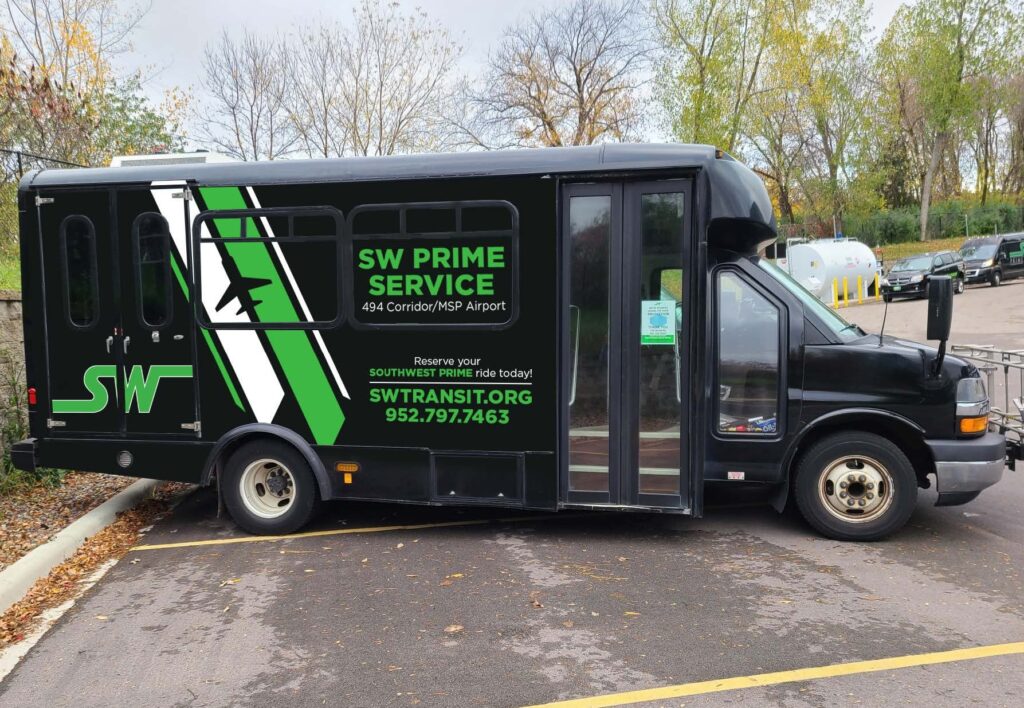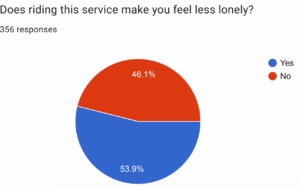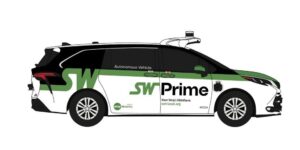Southwest Prime – Innovative and Autonomous Microtransit Service
15 minutes

Summary
- This brief builds on SUMC’s 2020 case study and highlights some of the new services offered by Southwest Prime and Southwest Transit.
- In 2015, Southwest Transit began its suburban microtransit service, SouthWest Prime.
- CMAQ funding has supported a majority of SouthWest Prime’s capital investments, including new Autonomous Vehicle technology.
- Community engagement and feedback have been an important part of SouthWest Transit’s understanding of community needs and program evolution.
- SouthWest Transit is launching an Autonomous Vehicle (AV) demonstration project in early 2025.
Introduction

SouthWest Transit and Prime Service Area.
Credit: SouthWest Transit
SouthWest Transit (SW Transit) operates in the municipalities of Eden Prairie, Chaska, Chanhassen, Carver, and Victoria, suburbs southwest of Minnesota’s Twin Cities. It also operates commuter services to downtown Minneapolis and the University of Minnesota campus. SW Transit offers fixed-route bus, on-demand, and shuttle services, providing several mobility options for the communities it serves, as well as connecting residents to the Twin Cities and the regional agency, Metro Transit.
SW Transit’s microtransit service, SouthWest Prime (SW Prime), offers shared, on-demand service throughout several zones in the agency’s operating area, working to fill the gap in mobility for all riders, and especially for older adults, people with disabilities, and low-income communities; according to SW Prime’s 2024 ridership survey, 53.6% of riders were aged 55+, and 13.8% of riders lived below the federal poverty level. Launched in 2015 and expanded several times since, SW Prime is an example of the customer appeal, mobility potential, and scalability of suburban microtransit service.
SW Prime History and Expansion
In July 2015, SW Transit launched SW Prime to address gaps in transportation in the community and make access to essential services more convenient and affordable through on-demand service. SW Prime works similarly to ride-hail services, where a user can request a ride on a mobile platform and be brought directly to their destination using a 12-passenger van. Since a demonstration began in 2015, SW Prime has expanded its permanent service to five suburban communities, in addition to express service to downtown Minneapolis and the University of Minnesota Twin Cities, Normandale Community College, MSP International Airport, and transit connections along the I-494 corridor. SW Prime initially operated Monday–Friday but later expanded its hours to address growing demand and needs determined by community outreach.
Community engagement has been central to SW Prime service, with efforts to activate marketing in local businesses, host test drives, and collect and address rider concerns. Community engagement efforts have been focused on raising awareness of benefits like cost savings and accessibility, especially compared to private ride-hail services.

Results from SW Transit’s 2024 ridership survey results.
Credit: SW Transit 2024 ridership survey.
Due to the service’s popularity, SW Transit undertook a service expansion, increasing the vehicle fleet (from 4 to 10) and starting planning subservices for specific populations and trip types. By 2019, expansion was completed to include service on Saturdays, non-emergency medical transport, and grocery store access. These connected users to essential services, including trips like picking up prescriptions or going in for a routine checkup, as well as piloting their grocery access program, Grocery Getter. The Grocery Getter pilot program took users to select grocery stores in the service region for $2 each way. While these two sub-services did succeed in bringing passengers to and from key destinations, a driver shortage led to their service ending in 2025.
2024 ridership survey data shows that SW Prime riders use the service for a range of largely local connections, including reaching social gatherings, grocery stores, libraries, senior centers, and other transit, specifically assisting riders who may encounter cost or mobility barriers for ride-hail usage. SW Prime’s nearly decade-long run emphasizes the value to riders of providing affordable service in less dense areas. Some 54% of SW Prime users in SW Transit’s 2024 survey responded that using SW Prime as a transportation option made them feel less lonely, demonstrating public transportation’s vital role in connecting people to their community, going beyond essential needs.
Autonomous Vehicles: The Next Iteration of SW Prime
Starting in 2025, SW Prime is enhancing service by incorporating an autonomous vehicle (AV) component to help reduce wait times, while also helping to address the national driver shortage.
Capital costs for autonomous service are primarily supported through federal grants, specifically the Congestion Mitigation and Air Quality Improvement (CMAQ) program, through which the agency was awarded $4.7 million over 3 years. This financial support is allocated for staff training, community engagement efforts, as well as the necessary funding for a private partner specializing in autonomous driving technology – May Mobility – who will help procure the proper vehicles and equipment. The vehicles themselves will be Toyota Siennas, equipped with AV technology.

Toyota Siennas are equipped with autonomous vehicle technology to service SW Transit’s customer base. Credit: SW Transit July 2024 press release.
SW Prime is working with Spare to manage the AV rides through its on-demand operations software. This partnership supports the booking and dispatch processes. The Spare technology allows riders to book on-demand trips. With the AV pilot, SW Prime hopes to also reduce the wait time (the window in which customers wait for their vehicle to arrive after booking) from 24 minutes to 15 minutes.
SW Prime plans to expand operations through two key mobility services by 2027: a mobility hub and a bikeshare program. A mobility hub is a central location for multimodal transportation, often offering rail and bus service, alongside other transportation options like bicycle and pedestrian amenities. In the case of SW Transit, this mobility hub will be located at Southwest Station in Eden Prairie following the construction of the new station on Metro Transit’s Green Line, allowing direct access to two SW Transit bus lines. Upon completing the construction of the new station, SW Transit hopes to implement a bikeshare program to connect residents to an additional first and last-mile service, as well as other transportation options.
Lessons Learned
When implementing an on-demand service such as microtransit, any transit agency will likely experience barriers to successful piloting, implementation, and establishing service. While challenges are not uncommon for a transit agency to experience, SW Transit shared a few key lessons learned that ensured project success for SW Prime, as well as the early stages of the AV service:
Start with a community needs assessment – Understand the user base.

Credit: SW Transit Ridership Survey
Beginning a project or service with extensive community engagement helps to ensure that the service will meet community needs. To understand who would be utilizing SW Prime services, SW Transit worked with the City of Eden Prairie and local businesses, learning that SW Prime would appeal to vulnerable populations and support independence, as it opens opportunities to accessing healthcare, employment, education, and other daily needs for vulnerable populations like older adults, people with physical or cognitive disabilities, low-income households, and people of color. This is particularly relevant for SW Transit given its large proportion of older adults, people with disabilities, and people who don’t have access to a personal vehicle. Many passengers of SW Prime’s service also use it for leisure and to get to and from social and recreational events. To appeal to this customer base, SW Prime aligned service schedules and operations to match their needs, including operating well before and after peak hours (as well as Saturdays) and keeping the one-way price affordable.
Ensure that passengers are aware of the service.
Building awareness of on-demand microtransit services can be challenging for transit agencies. Without adequate community engagement, marketing, and branding, passengers may only be aware of fixed-route service. To address this, SW Transit ensured that SW Prime was not only marketed effectively but also integrated into transit planning tools. Collaborating with local businesses and government agencies, SW Transit educated the community about SW Prime and demonstrated its ease of use and low cost. Strategic marketing, community engagement, and the integration of GTFS-Flex are demonstrating the value and accessibility of SW Prime, ultimately growing its passenger base.
Adaptability is essential to a sustainable service model.
Recovering from the Covid-19 pandemic, ridership numbers declined for many US transit agencies and many transit agencies are experiencing vehicle mechanic shortages. SW Prime’s AV service is looking to test autonomous solutions to fill this gap and reduce customer wait times. SW Prime estimates that the average wait time will decrease from 25 minutes to 9 minutes with the introduction of AV service.
Conclusion
SWTransit’s implementation and evolution of SW Prime demonstrates the agency’s commitment to advancing the mobility landscape in suburban and less dense landscapes. Prioritizing community engagement and adaptability has helped SWTransit design on-demand microtransit solutions and autonomous vehicle services to meet rider needs and support its operations. Looking ahead, SW Prime’s planned mobility hub and bikeshare program is looking to support access to transit service and provide additional transportation options.
For additional information on SouthWest Transit or SouthWest Prime service, please visit SouthWest Transit’s website.